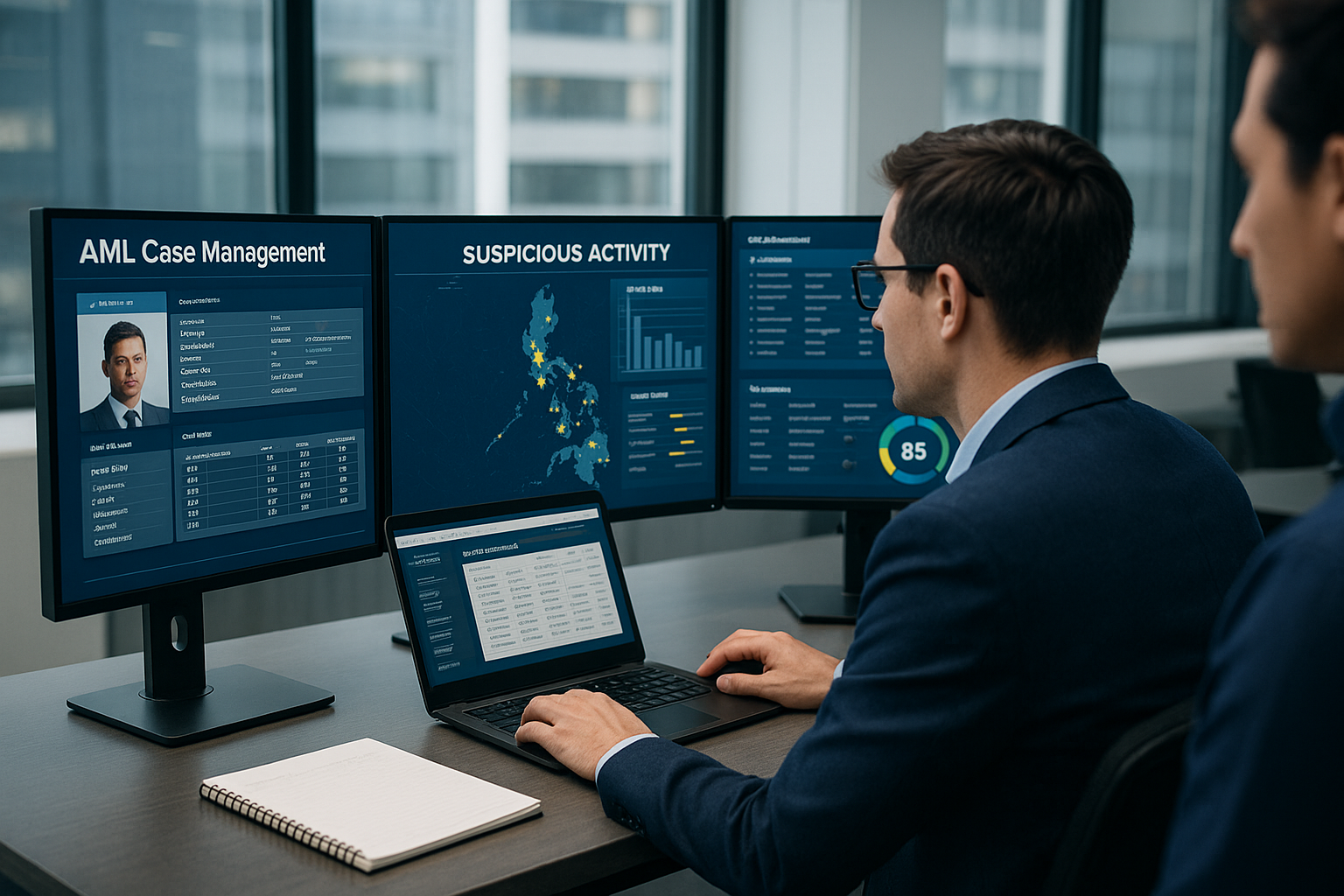Top Fraud Detection Companies and Software Solutions Using AI
.svg)
Today, fraud has become a growing concern for businesses of all sizes. Criminals are constantly finding new ways to exploit vulnerabilities, costing companies millions in losses. To combat this, many organizations are turning to advanced fraud detection software to safeguard their operations.
Fraud detection solutions, especially those powered by artificial intelligence (AI), have revolutionized how businesses protect themselves from threats. With AI’s ability to process vast amounts of data and identify suspicious patterns in real time, fraud detection has never been more accurate or efficient. In this guide, we’ll explore the top fraud detection companies and the key software solutions they offer, helping you make an informed choice to protect your business from fraud.
What is Fraud Detection and Why is it Essential?
Fraud detection is the process of identifying suspicious activities or transactions that may indicate fraud. This could involve anything from stolen credit cards to identity theft or money laundering. In today's digital world, fraud has become more sophisticated, making it harder for businesses to detect without the right tools.
Fraud detection is essential because it helps protect businesses from financial losses. It also keeps customers’ personal and financial information safe. Without proper fraud detection systems, companies can face major risks, including damage to their reputation and large fines for non-compliance with regulations.
As fraud tactics evolve, it’s important for businesses to use advanced fraud detection software. These tools help identify threats early, allowing companies to take quick action. Using artificial intelligence (AI) in fraud detection has made the process even more efficient, ensuring better accuracy and faster responses to potential risks.
{{cta-first}}
Key Features to Look for in Fraud Detection Software
When selecting fraud detection software, it's important to understand what makes a solution effective. The right features can make a big difference in identifying and stopping fraud before it impacts your business. Here are the key features to look for:
1. AI and Machine Learning Capabilities
Artificial intelligence (AI) and machine learning are game-changers in fraud detection. They analyze large amounts of data quickly and learn from past patterns to detect suspicious activity in real time. This means faster and more accurate identification of fraud.
2. Real-Time Transaction Monitoring
Fraud detection software should monitor transactions as they happen. This allows businesses to stop fraudulent transactions immediately before they cause damage. Real-time monitoring is crucial for industries like banking and e-commerce, where high volumes of transactions occur every minute.
3. Comprehensive Risk Analysis
An effective fraud detection tool assesses the risk of each transaction or action. By looking at factors such as the user’s location, behavior, and transaction history, the software can provide a complete picture of potential risks. This ensures that high-risk activities are flagged for further investigation.
4. Integration with Existing Systems
Your fraud detection software should easily integrate with your current systems, such as customer databases or payment processing platforms. This seamless integration improves efficiency and ensures that all areas of your business are protected from fraud.
These features are essential for ensuring that your business stays one step ahead of fraudsters. They also help reduce false positives, so you can focus on real threats instead of wasting time on minor issues.
The Top Fraud Detection Software Companies of 2024
With the rise in fraud cases, many companies have developed advanced software to help businesses detect and prevent fraud. Below are some of the top fraud detection software companies of 2024, including Tookitaki, a leader in AI-powered fraud detection.
1. Tookitaki: AI-Powered Fraud Detection Software
Tookitaki is at the forefront of fraud detection, using advanced artificial intelligence to provide businesses with real-time monitoring and predictive analysis. Its Anti-Financial Crime (AFC) Ecosystem leverages collective intelligence to continuously update fraud patterns, making it one of the smartest solutions on the market.
2. ComplyAdvantage
ComplyAdvantage offers a comprehensive fraud detection solution, known for its ability to monitor transactions in real-time and prevent fraud across various sectors. It uses advanced algorithms and machine learning to detect suspicious behavior and reduce false positives, helping businesses stay compliant with regulatory requirements.
3. Salv
Salv’s fraud detection software focuses on providing AI-driven solutions for financial institutions. With its innovative approach, Salv helps businesses identify fraud by analyzing large amounts of data quickly and effectively. Their customizable solutions make it easier for companies to meet their unique fraud prevention needs.
4. Finscore
Finscore is known for its fraud analytics tool, which helps businesses manage fraud risks and monitor transactions efficiently. By using machine learning, Finscore’s tool can detect fraud patterns and anomalies in real time, offering a reliable solution for banks and fintech companies.
Each of these companies offers strong fraud detection solutions, but Tookitaki stands out with its community-driven intelligence and AI-powered platform. It ensures businesses are always up to date with the latest fraud prevention strategies, making it a leading choice for fraud detection.
How Artificial Intelligence is Revolutionizing Fraud Detection
Artificial intelligence (AI) is changing the way businesses detect and prevent fraud. Traditional methods of fraud detection often rely on fixed rules or manual reviews, which can be slow and ineffective against modern threats. AI, however, offers faster, smarter, and more efficient ways to spot fraudulent activities before they cause damage.
1. Faster Detection and Response
AI-powered fraud detection tools can process huge amounts of data in real time. This allows businesses to detect suspicious behaviour as it happens, rather than after the fact. With AI, companies can respond to threats immediately, reducing the risk of financial loss.
2. Learning from Past Fraud Patterns
One of AI’s greatest strengths is its ability to learn from past data. By analyzing patterns of previous fraud cases, AI systems can predict and identify new forms of fraud. This means that the software doesn’t just rely on old rules—it adapts to new threats as they emerge.
3. Reducing False Positives
False positives—when legitimate transactions are flagged as suspicious—are a big problem in traditional fraud detection. AI helps reduce these false positives by making more accurate decisions based on comprehensive data analysis. This saves time and resources, allowing businesses to focus on real threats.
4. Scalable Solutions for Growing Businesses
As businesses grow, so do their transaction volumes. AI-based fraud detection software is designed to scale with businesses, ensuring they remain protected no matter how large they become. AI tools can handle increasing amounts of data without sacrificing speed or accuracy.
Tookitaki is one of the companies leading this AI revolution. Its Anti-Financial Crime (AFC) Ecosystem and FinCense platform use AI to provide real-time fraud detection that continuously learns and adapts to new fraud tactics.
Benefits of Using Fraud Detection Software
Fraud detection software is a critical tool for businesses in today’s digital age. By using advanced technology, companies can protect themselves from financial losses and safeguard their customers. Here are the key benefits of using fraud detection software:
1. Enhanced Compliance and Reduced Risk
Fraud detection software helps businesses comply with strict regulations. Many industries, especially finance and e-commerce, have legal requirements to prevent fraud and money laundering. The right software ensures that companies meet these regulations, reducing the risk of hefty fines or penalties.
2. Real-Time Monitoring for Faster Fraud Prevention
One of the biggest advantages of fraud detection software is its ability to monitor transactions in real time. This means suspicious activities can be identified and stopped immediately, minimizing the impact on the business. Real-time monitoring is especially important for industries like banking, where high-volume transactions are common.
3. Reduction in False Positives
Traditional fraud detection methods often flag legitimate transactions as fraudulent, causing unnecessary delays and customer dissatisfaction. Fraud detection software, especially those powered by AI, significantly reduces false positives by analyzing data more accurately. This helps businesses focus on real threats without wasting time on false alarms.
4. Improved Customer Trust
When customers know their transactions are secure, they are more likely to trust a business. Fraud detection software provides an extra layer of security, protecting customer data and preventing unauthorized access. This can improve customer loyalty and boost a company’s reputation.
5. Cost Efficiency
While investing in fraud detection software may seem expensive upfront, it can save businesses money in the long run. By preventing fraud-related losses and reducing compliance costs, these tools offer a high return on investment. They also help streamline operations by automating the fraud detection process.
With fraud detection software like Tookitaki’s, businesses can benefit from these advantages and stay ahead of potential risks. Tookitaki’s AI-driven solutions provide comprehensive coverage and real-time monitoring, ensuring your company is protected at all times.
Choosing the Best Fraud Detection Company for Your Business
Selecting the right fraud detection company is crucial to protecting your business from financial crime. With so many options available, it’s important to understand what sets the best fraud detection companies apart. Here are some factors to consider when choosing the best solution for your needs:
1. Industry-Specific Expertise
Every industry faces different fraud risks. For example, banks may need stronger protections against identity theft and money laundering, while e-commerce businesses might face issues with payment fraud. Make sure to choose a fraud detection company that understands your industry and offers solutions tailored to your specific risks.
2. Scalability of Solutions
As your business grows, so will your need for fraud protection. Look for a fraud detection tool that can scale with your business. The best fraud detection software should be flexible and able to handle increasing transaction volumes without losing efficiency.
3. Real-Time Fraud Monitoring and AI Capabilities
Fraud happens quickly, and real-time monitoring is essential for stopping it in its tracks. AI-powered fraud detection tools offer the advantage of learning from past fraud patterns and predicting new ones. Companies like Tookitaki use advanced AI to ensure that their systems are always one step ahead of fraudsters.
{{cta-ebook}}
4. Integration and Ease of Use
It’s important that your fraud detection software integrates smoothly with your existing systems. The best solutions will offer easy integration with minimal disruption to your current operations. Tookitaki’s FinCense platform, for example, is designed to work seamlessly with other compliance and monitoring systems, making it easy for businesses to adopt.
5. Cost-Effectiveness
Consider the cost of implementing and maintaining fraud detection software. While top-tier solutions might require an upfront investment, they can save your business from costly fraud incidents and fines for non-compliance. Tookitaki’s fraud detection solutions are not only powerful but also provide cost savings by reducing false positives and improving compliance efficiency.
By carefully evaluating these factors, you can choose a fraud detection company that meets your business needs. Tookitaki, with its customizable AI-driven solutions, is trusted by financial institutions and businesses worldwide.
Conclusion
Fraud detection has become more critical than ever. The right fraud detection software can protect your business from significant financial losses, help you stay compliant with regulations, and maintain customer trust. With advancements in artificial intelligence, companies like Tookitaki are leading the way in offering smarter, more efficient fraud detection solutions.
By choosing a solution that offers AI-powered real-time monitoring, scalability, and easy integration, you ensure your business is equipped to handle both current and future fraud risks. Whether you are a financial institution, an e-commerce business, or a fintech company, investing in the best fraud detection software is essential for your long-term success.
Take the next step: Explore how Tookitaki’s AI-powered fraud detection tools can help protect your business and keep you ahead of fraudsters.
Experience the most intelligent AML and fraud prevention platform
Experience the most intelligent AML and fraud prevention platform
Experience the most intelligent AML and fraud prevention platform
Top AML Scenarios in ASEAN

The Role of AML Software in Compliance

The Role of AML Software in Compliance










